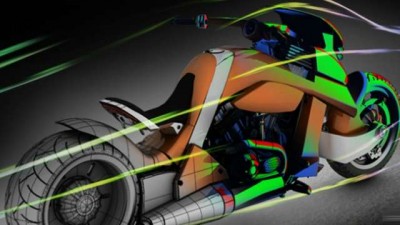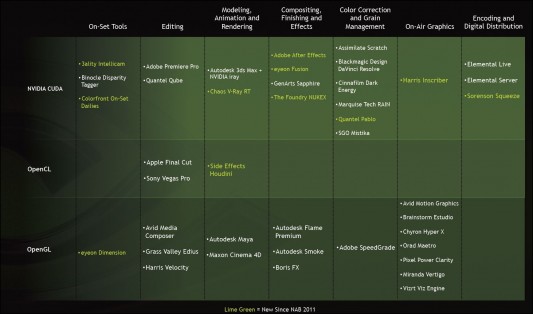More than 40 vendors had Nvidia GPU technology in their booths. OpenCL is out there, but CUDA is doing well.
Nvidia had no new product announcements at the recent National Association of Broadcasters (NAB) convention, but the company did highlight partnerships for its various technologies including GPU compute, its SDKs, and Maximus.

Nvidia marketing executive Greg Estes said Nvidia technology was being shown in over 40 booths. Adobe may be one of Nvidia’s most important partners. Adobe’s Mercury playback engine was originally built on CUDA so Adobe’s CS 6 products run faster (it now uses OpenCL as well). This year After Effects has implemented CUDA and Adobe has used the Nvidia Optix engine. The newly tweaked After Effects now has 3D typefaces, it has ray tracing effects, and motion blur. Also After Effects can take advantage of Maximus.
Nvidia, ever in to numbers notes (frequently) that ray tracing is 27 times faster thanks to Maximus. So what happens here is that Adobe’s CS6, and especially After Effects has an even stronger role to play in the big leagues with much improved performance.
On that same path, Adobe has recently acquired SpeedGrade, a professional color grading product that was sold as a high-end product. Adobe is throwing it in to the CS 6 subscription package. Right now, it is hardware accelerated through OpenGL, but it seems likely Adobe will increase the product’s use of GPU compute to keep it competitive.
In fact, there was just such a competitor nearby in Nvidia’s booth—Cinnefilm Dark Energy is also a high-end user of GPUs. Dark Energy is being used to add grain back in to content captured with DSLR cameras to eliminate that “video look.” It’s also used for retiming color values. Estes tell us it can soak up all the Tesla GPUs you throw at it. Other examples of Nvidia in the mix include Autodesk’s use of Tesla GPUs to speed simulations in Maya, enabling more real-time interaction for the animator working with particle systems.
Also, the Chaos V-Ray RT renderer is making use of Nvidia technology for ray tracing and can also offer real time interaction for rendering and modeling. Chaos now has a RT version for 3ds Max optimized for CUDA, and a Maya version coming soon. Chaos Group also continues to develop and support V-Ray RT for OpenCL as well, which is universally compatible with GPUs. V-Ray RT can leverage Nvidia’s Maximus technology, taking advantage of multiple GPUs simultaneously.
We had a quick visit with Elemental’s Lisa Epstein in the Dell booth who told us about the company’s use of Tesla GPUs in the Elemental Live 150 series. The company is looking forward to the Olympics where there is going to be much more acceptance of digital video over IP for even the major events.
The case for CUDA
While Nvidia admits the existence of OpenCL and offers support, the company says it is getting new customers for CUDA and it is not seeing a shift to OpenCL even though OpenCL gives developers a cross-platform approach. What Nvidia’s booth really demonstrates is that customers are seeing the benefits of optimizing for multi-core and GPU compute and they aren’t waiting for the OpenCL tools to evolve or for Intel to get tools out there for its multi-core MIC processor. There really was an impressive amount of Nvidia partners at NAB this year. The case has been made for multi-core, for GPU compute, and, for now, CUDA.






